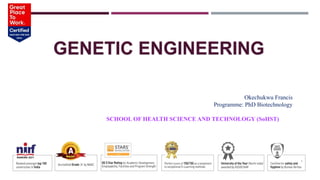
Genetic engineering.pptx
- 1. GENETIC ENGINEERING 1 Okechukwu Francis Programme: PhD Biotechnology SCHOOL OF HEALTH SCIENCE AND TECHNOLOGY (SoHST)
- 2. INTRODUCTION Genetic engineering, also known as genetic modification or gene editing, is a technique that allows scientists to alter the genetic makeup of an organism. It involves the manipulation of DNA (deoxyribonucleic acid), which carries genetic information and controls the development and functioning of all living organisms. Genetic engineering has revolutionized fields such as medicine, agriculture, and industry, and has the potential to address some of the world's most pressing challenges. Figure 1: showing gene knockout (source: https://en.wikipedia.org/wiki/Genetic_engineerin
- 3. HISTORY OF GENETIC ENGINEERING The field of genetic engineering has its roots in the discovery of DNA's structure by James Watson and Francis Crick in 1953. In the early 1970s, researchers developed the technique of recombinant DNA, which allowed them to insert foreign DNA into a bacterial cell. This led to the production of the first genetically modified organism (GMO) in 1973, a bacterium that was resistant to the antibiotic kanamycin. Since then, genetic engineering techniques have continued to evolve, with the development of new tools such as restriction enzymes, polymerase chain reaction (PCR), and more recently, gene editing tools such as CRISPR/Cas9. Fig 2: showing CRISPR-Cas gene editing (source: https://www.labiotech.eu/in-depth/crispr-cas9-review-gene-editing- tool/)
- 4. TECHNIQUES OF GENETIC ENGINEERING There are several techniques used in genetic engineering, few of them includes: 1. Polymerase chain reaction (PCR): This is a technique that allows scientists to amplify specific segments of DNA, making it easier to study and manipulate them. 2. Gene editing tools: These include CRISPR/Cas9, which uses a "molecular scissors" to cut DNA at specific locations, and then insert, delete or replace genes. 3. Gene synthesis: This involves creating artificial DNA sequences in a laboratory, which can be used to create or modify new genes.
- 5. APPLICATIONS OF GENETIC ENGINEERING: GENETIC ENGINEERING HAS A WIDE RANGE OF APPLICATIONS IN VARIOUS FIELDS, INCLUDING: 1. Medicine: Genetic engineering has the potential to revolutionize healthcare by enabling the development of personalized medicine and gene therapy. It has already been used to create genetically modified cells that can fight cancer, and to develop vaccines for diseases such as hepatitis B. 2. Agriculture: Genetic engineering has been used to create crops that are resistant to pests and diseases, and that have improved nutritional content. This has the potential to increase crop yields and reduce the use of pesticides and other chemicals. 3. Industry: Genetic engineering has been used to create enzymes that can be used in a variety of industrial processes, such as the production of biofuels and the breakdown of waste materials. 4. Environmental conservation: Genetic engineering has the potential to help address environmental challenges such as pollution and climate change. For example, genetically modified bacteria can be used to clean up oil spills, and genetically engineered crops can help reduce greenhouse gas emissions.
- 6. ETHICAL CONSIDERATIONS OF GENETIC ENGINEERING: As with any new technology, genetic engineering raises ethical questions and concerns. Some of the potential risks and challenges include: 1. Safety: Genetic engineering has the potential to create unintended consequences, such as harmful mutations or unintended effects on other organisms. 2. Regulation: There is a need for strong regulatory frameworks to ensure that genetic engineering is used responsibly and safely. 3. Equity: There is a concern that genetic engineering could exacerbate social and economic inequalities, by creating new technologies that only benefit certain groups. 4. Social and cultural impacts: Genetic engineering raises questions about the impact on society and culture, including questions about the value of life and the role of technology in shaping our world.
- 7. FUTURE OF GENETIC ENGINEERING Genetic engineering has the potential to revolutionize various fields and address some of the world's most pressing challenges. As the field continues to evolve, here are some of the potential future developments: Precision medicine: With the help of genetic engineering, it may be possible to develop more precise and personalized treatments for a range of diseases. This could involve using gene editing tools to correct genetic mutations that cause diseases or creating genetically modified cells that can target and destroy cancer cells. Synthetic biology: Genetic engineering could enable the creation of completely new organisms or biological systems. This could involve creating synthetic bacteria that can produce biofuels or other useful substances, or engineering plants to produce medicines.
- 8. FUTURE OF GENETIC ENGINEERING Gene drives: Gene drives are a technique that enables the spread of a particular gene through an entire population of organisms. This could be used to eliminate disease-carrying insects or to promote the spread of beneficial traits in plants or animals. Environmental applications: Genetic engineering has the potential to help address environmental challenges such as climate change and pollution. For example, genetically modified bacteria could be used to break down plastics or clean up oil spills, while genetically engineered crops could help reduce greenhouse gas emissions. Ethical and social considerations: As genetic engineering continues to develop, there will be important ethical and social considerations to address. These may include questions about the safety and regulation of genetic engineering, the impact on social and economic inequalities, and the role of genetic engineering in shaping our world and our values.
- 9. CONCLUSION Genetic engineering is a powerful and rapidly evolving technology that has the potential to revolutionize fields such as medicine, agriculture, and industry. While it offers many benefits, such as creating personalised treatments and improving crop yields, it raises ethical questions and concerns around safety, regulation, equity, and social and cultural impacts. The future of genetic engineering is promising, with ongoing advancements in tools and techniques that will enable scientists to address some of the world's most pressing challenges, such as disease, hunger, and environmental degradation. However, it is important that we approach genetic engineering with caution and careful consideration, to ensure that it is used responsibly and safely and that its benefits are accessible to all.
- 10. THANK YOU
